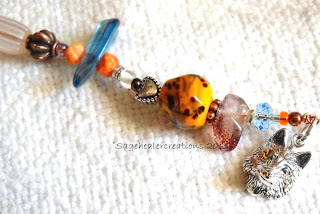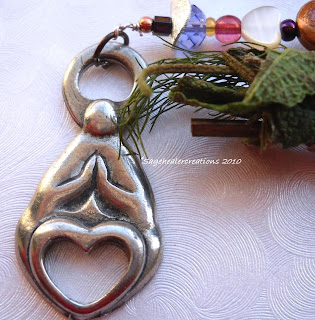Many indigeous cultures and religious practices use herbs for cleansing and healing - as incense, essential oil, and as fresh or dry herbs. Cultural and healing lore teaches that smudging is calming and cleansing. Those of us who smudge regularly know that smudging clears the environment of negative energy and helps purify our spirit. Brushing the sacred smoke around the body is calming and centering.

I was recently honored with an invitation to teach two lessons on smudging to art classes at the Ace Charter School last month (March). Here's the story ...
Coming mostly from low income Latino families, these middle school students are some of the lowest achieving kids in their San Jose school district. Many come from rough homes. Quite a few have behavior problems. In their art classes, the students have been studying Native American culture.
Their teacher, Helene Erlich, works very hard to give them positive experiences and to teach life lessons that reinforce self esteem. She contacted me after becoming a fan of my art on
Etsy.

From the moment I received this most unexpected invitation, and as we worked out the class details, I was deeply touched both by the teacher's caring for her students. We both knew these kids need opportunities for learning something that is healing in their lives, and that can help them change their own state of mind and their environment.
Class 1:
In the first class, the theme of preparing for Spring Equinox was used for introducing the sacred smudging ceremony. The students learned about the sacred practice of smudging, how to get centered, and about thanking the plant spirits. They learned that fragrant herbs used in the smudge stick - such as fennel for love and healing, lavender for calm and happiness, rosemary for success and clear thinking, sage for cleansing - bring energies from the plants into the physical, mental and emotional environment. They experienced smudging themselves and then someone else. (I crafted the smudge sticks they used from fennel, lavender, rosemary, and Mexican Sage [
S. leucantha]).

Each small group had a campfire (candle) and a plastic egg rattle to use.
During discussions at the end of each class, many students - without prompting - said they felt "better", "happy", "calm", "relaxed", "more energized". One young girl who was recovering from surgery on both feet and using a walker said that she felt pain free for the first time since her surgery was over.
Class 2:
Students learned how to make their own smudge sticks in the second class. Smudge sticks are fairly easy to make. Most important is understanding that the herbs used are considered sacred, and approaching the creating in the right manner of respect and gratitude.

Handling the sacred herbs during the crafting is a wonderfully healing and uplifting experience.
For two days before the class, I prowled neighborhoods (Black Lab in tow) in two towns to gather enough Lavender, Rosemary, and Sage leaves for use by 110 students. Happily, Fennel is growing abundantly all around my neighborhood right now.

Most of the students were fully engaged in the process.

Some of the smudge sticks were quite creative!

And the smiles that lit so many young faces when I told them they did a wonderful job was a real joy to experience for all of us.
Research to Do !
Two questions were asked that prompted quite a bit of research on my part afterwards.
Quite a few students were very interested in the love energy aspect of fennel. When talking about fennel being an herb that attracts love, one girl asked me how that works (she may have been the one holding hands with a boy near the herb table). I answered that using fennel in a smudge clears your own energy and helps you feel more loving, and that attracts love back to yourself. And there are tiny particles in the smoke that move out into the universe and take this energy to others, plus stays around you - working like a hummingbird comes to a flower.
I realized that even though I've been smudging for years, and fully embraced all of the benefits that have been written about and I've experienced, I wanted to have a "technical understanding" of how and why. So, I began researching.

Understanding how smudging works begins with the sense of smell and the brain's limbic system. Fragrance has a direct, primal and powerful impact. The limbic system is a complex arrangement of brain functions that regulate everything from emotions to learning to responding to stimuli.
This system is responsible for creativity, inspiration, and automatic life processes for survival including heartbeat, hormone regulation and respiration.
Next, remember that everything in existence has energy . Science has shown that everything in existence consists of atoms and molecules. The movement of atoms creates energy that has an electromagnetic "vibration". Everything is energy and thus has a vibration. Chi, the vital Life Force in all living things, is energy. Smell is molecular. Emotions are energy.
When you sniff an aroma, the fragrance travels up the nasal passage to the olfactory bulb, where - bypassing the blood-brain barrier - the odor molecules directly enter the limbic system. The limbic system is made up of many brain structures related to survival. This is where our brain processes emotions, and motivations such as fear, anger, and pleasure. Memory, happiness, decision making, heart rate, blood pressure, sexual response and creativity are all based in the limbic system. 
Abalone Shell Bowl -
WillowRavenBeads
The limbic system is where atoms meet - and affect - emotional energy. The sense of smell is directly linked to health, relaxation, emotional well being, our reactions and to decisions we make. This is why fragrance has such an important role in religious ceremonies, and why aromatherapy works.
So, the short answer seems to be: the molecules in the herbal smudging smoke attach to the negative energy within the person and/or the environment. As the smoke dissipates (being exhaled and/or dissolving and moving out of the room), the negative energy is cleared away, or perhaps the smoke molecules actually change the molecular structure of the other energy. Since plants have energy, their unique qualities - for healing, change, purification - are part of the smoke and are absorbed into the body and environment. [I personally believe that the "brushing" action also has an important role - a subject for another day]
The second question was about using cilantro in smudge sticks, since many of the students were of Hispanic heritage and had this herb growing at home. Since I was not very familiar with cilantro, I needed more information.
Turns out that Cilantro has been used as a healing herb for 5,000 years.Cilantro is also known as coriander (all the same plant - cilantro is the leaf, coriander the seed), Chinese Parsley or Mexican Parsley. The Chinese used cilantro/coriander in love potions as they believed that it had aphrodisiac qualities (the kids will love that answer!). It is referenced in the Bible, and the ancient Romans are credited with spreading the plant throughout Europe. The herb was brought to the Americas (Central and South America) by the Spanish Conquistadors, making cilantro one of the earliest cultivated herbs in the western hemisphere.
Kicking Bear
Cilantro was referenced by many sources I reviewed as a common herb in smudge sticks, though I found no specific descriptions of it's metaphysical qualities. Medicinally, eating Cilantro has been found to remove mercury and other toxic metals from the brain and central nervous system into other tissues. Herbalists and aromatherapy sources say that Cilantro/Coriander contains an essential oil that helps in the healing of digestive problems (such as flatulence, indigestion and constipation), eliminates toxins, stimulates circulation, eases migraine, prevents infection and salmonella, and treat rheumatism and arthritis.
One herbalist colleague believes that coriander/cilantro would lift heaviness away, just as it helps the body get rid of heavy metals, especially mercury. Cilantro's light and clean tasting qualities probably make it feel "like soap for the spirit," she says.
Many people I've contacted recently on this topic would be interested in hearing about Cilantro in smudge sticks. Please send me - or post - your comments!
And lastly, I am delighted to share what Helene Erlich, the art teacher, wrote about the classes:
"It was beautiful and perfect timing. This ceremony, whether they realized it or not, helped cleanse some of the energy that stops their growth. "
Partial List of Resources and Suggestions for More Information:
Aromatherapy and SmudgingAromatherapy and Limbic System
Coriander
Cilantro
Limbic System
National Plant Data Center
Sage Uses
Smudging Fan by Rekamekip

Limbic System Photo
Questions about smudging or smudging herbs? Just ask - I have lots of experienced smudging colleagues who would be delighted to share their experiences!





























 And the smiles that lit so many young faces when I told them they did a wonderful job was a real joy to experience for all of us.
And the smiles that lit so many young faces when I told them they did a wonderful job was a real joy to experience for all of us.


